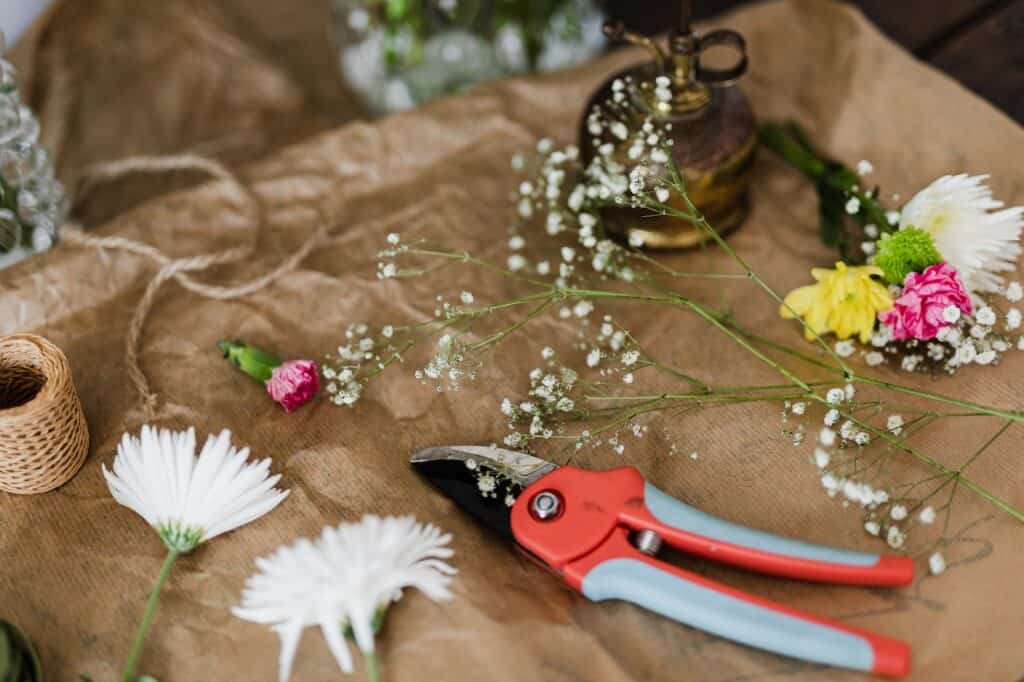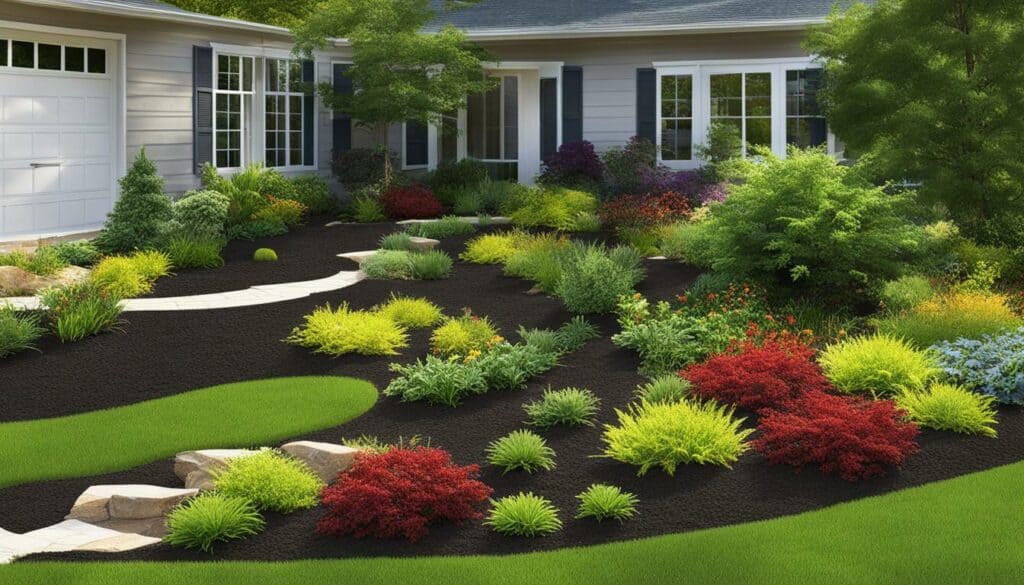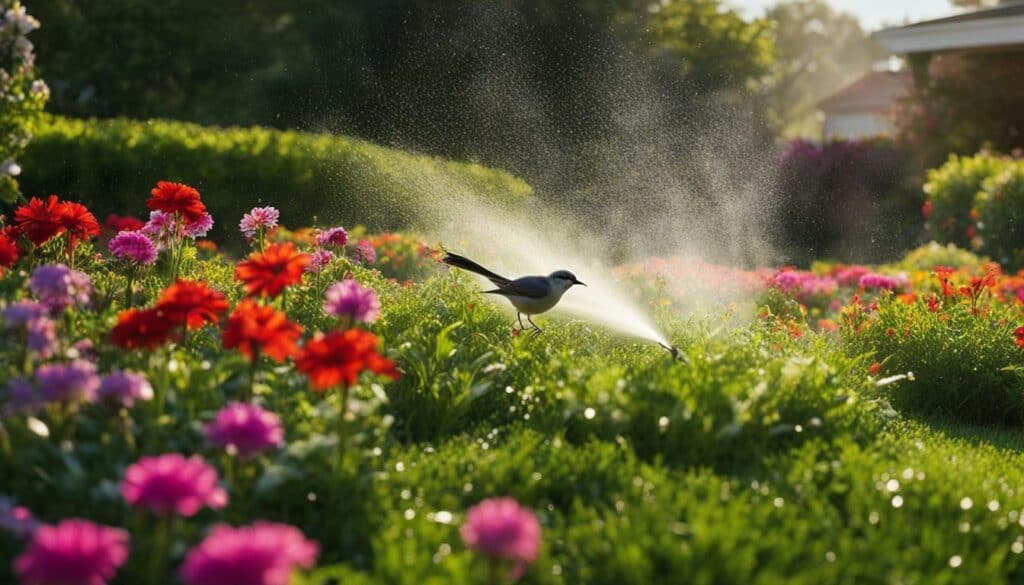Greetings, fellow gardeners and landscaping enthusiasts! Are you ready to unleash your green thumb and transform your yard into a stunning oasis? In this article, I’ll share my top basic garden landscaping ideas, perfect for budding gardeners in the US.
Key Takeaways:
- Planning your garden layout is essential for successful landscaping.
- Nourish your soil with organic matter like compost and mulch to promote healthy plant growth.
- Embrace plant diversity to create a visually appealing and balanced garden.
- Learn the art of pruning to maintain plant health and encourage flowering.
- Discover the magic of mulching for moisture conservation and soil enrichment.
- Maintain a well-manicured lawn through proper mowing techniques and soil care.
- Water your garden wisely to conserve water and promote healthy plant growth.
- Control pests naturally by using companion planting and attracting beneficial insects.
- Adapt your gardening practices according to the changing seasons for successful garden maintenance.
- Consider hiring professional landscaping services for expert help.
Plan(t) with Purpose
Before you dig in, it’s essential to plan your garden with purpose. Take the time to envision your dream outdoor space and consider factors such as sunlight exposure, soil quality, and the overall style you desire. Sketch out a rough layout to guide your efforts and find inspiration from various apps and websites.
Find Inspiration Online
Exploring garden planning apps and websites can provide a wealth of design ideas and practical advice. These resources are often free and can help you visualize your dream garden. Whether you’re looking for layout inspiration, plant recommendations, or tips from experienced gardeners, these platforms are a treasure trove of information. Some popular options include:
- Garden Planner: This online tool allows you to create a customized garden plan, complete with plant selections and design elements. It offers a user-friendly interface and the ability to view your garden design in 3D.
- Pinterest: This image-driven platform is a fantastic resource for finding garden layout inspiration. Create boards for different garden styles and save images that resonate with your vision.
- Garden Compass: This app provides personalized recommendations for plants that will thrive in your specific location. Simply input your zip code, and the app will suggest suitable plants based on your climate.
Consider Your Garden Layout
When planning your garden layout, think about how you want the space to function and the overall aesthetic you’re aiming for. Here are a few layout ideas to consider:
- Traditional Rows: This classic layout involves planting rows of vegetables and flowers, creating a neat and organized look. It’s a practical option if you have a large plot and want to maximize productivity.
- Container Gardening: If you have a small space or limited mobility, container gardening is a great option. Utilize pots, hanging baskets, and raised beds for a versatile and accessible garden.
- Theme Gardens: Create a garden with a specific theme in mind, such as a butterfly garden, herb garden, or a Mediterranean-inspired oasis. This approach allows you to curate plants that fit your chosen theme and create a cohesive design.
Remember, your garden layout should be a reflection of your personal style and the functionality you desire. Don’t be afraid to get creative and make your garden space uniquely yours.
By planning with purpose and finding inspiration from various sources, you can create a garden layout that meets your needs and brings your vision to life. Whether you prefer a traditional row garden or a themed oasis, careful planning will ensure a beautiful and functional outdoor space.
Next, let’s explore the importance of soil quality in creating a thriving garden.
Soil, the Silent Hero
The foundation of any successful garden lies beneath the surface – the soil. To ensure your plants thrive, it’s essential to nourish your soil with organic matter such as compost. Additionally, consider using mulch, lawn clippings, and cover crops to enrich the soil and promote good plant growth.
Organic matter, such as compost, is a key ingredient in creating healthy soil. Compost is rich in nutrients and beneficial microorganisms that help plants grow strong and resist diseases. It also improves soil structure, allowing for better water retention and root penetration. Adding compost to your garden beds or mixing it into your potting soil will provide a nutrient-rich foundation for your plants.
Another way to improve soil health is by using mulch. Mulch acts as a protective layer on top of the soil, preventing moisture loss, regulating soil temperature, and suppressing weed growth. It also breaks down over time, adding organic matter to the soil and improving its fertility. Organic materials such as straw, wood chips, or shredded leaves make excellent mulch choices.
Lawn clippings can also be used to enrich the soil. Instead of bagging and disposing of grass clippings, leave them on the lawn as a natural fertilizer. The clippings will break down and release nutrients back into the soil, reducing the need for synthetic fertilizers. Just be sure to mow regularly and not remove more than one-third of the grass height at a time.
Benefits of Cover Crops
Incorporating cover crops into your gardening routine is another excellent way to improve soil health. Cover crops are plants grown specifically to benefit the soil, rather than for harvest. They help prevent soil erosion, suppress weeds, and add organic matter to the soil when they’re tilled under.
Legumes, such as clover or vetch, are popular cover crop choices because they have nitrogen-fixing properties. They form a symbiotic relationship with bacteria in their roots, converting atmospheric nitrogen into a form that plants can use. This natural nitrogen fixation process helps enrich the soil with this essential nutrient.
Grasses and grains, such as rye or oats, are also common cover crops. They have deep root systems that improve soil structure, promote water infiltration, and scavenge excess nutrients. When tilled under, they add organic matter and nutrients to the soil, improving its overall fertility.

“Healthy soil is the foundation of a successful garden. By nourishing the soil with organic matter, you provide the essential nutrients and a thriving ecosystem for your plants to grow. It’s like giving them a healthy meal and a supportive community all in one!”
Incorporating organic matter, such as compost and mulch, and using cover crops are all excellent ways to nourish your soil and create the ideal growing conditions for your plants. By investing in the health of your soil, you’ll be rewarded with healthy, vibrant plants that flourish and beautify your garden.
Embrace Diversity
Nature thrives on diversity, and so should your garden. To create a visually stunning landscape, aim for a mix of plant species that bloom at different times of the year. By embracing diversity, you’ll attract beneficial insects and create a natural balance in your garden. Consider companion planting to further enhance biodiversity.
Companion planting involves strategically planting different species together to promote mutual benefit. Some plants repel pests, while others attract beneficial insects that help control garden pests naturally. For example, planting marigolds near tomatoes can deter aphids, and growing lavender near roses can attract pollinators like bees and butterflies.
To help you plan your diverse garden, here is a list of plants that bloom in different seasons:
- Spring: Tulips, daffodils, lilacs, and peonies
- Summer: Sunflowers, zinnias, cosmos, and dahlias
- Fall: Mums, asters, sedums, and goldenrods
- Winter: Hellebores, pansies, winter jasmine, and snowdrops

By incorporating plants with different blooming seasons, you’ll create a vibrant and ever-changing display of colors and textures throughout the year. This not only enhances the visual appeal of your garden but also provides a continuous food source for pollinators and beneficial insects.
Companion Planting: Creating a Harmonious Garden
In addition to considering blooming seasons, companion planting can be used to create a harmonious garden that maximizes plant growth and repels pests naturally. Here are a few examples of companion plants:
| Companion Plants | Benefits |
|---|---|
| Basil and tomatoes | Basil repels aphids and tomato hornworms |
| Marigolds and roses | Marigolds repel aphids and attract beneficial insects |
| Lavender and mint | Lavender repels moths and mint repels ants |
By strategically planting these companion plants, you can create a garden ecosystem that supports the natural growth and protection of your plants.
Remember, diversity is the key to a thriving garden. Embrace the beauty of different plant species and the benefits they bring. Your garden will become a haven for both you and the remarkable diversity of nature.
Pruning Techniques for Healthy Growth and Beautiful Flowers
Pruning may sound intimidating, but it’s a necessary practice for maintaining healthy plants. Regular pruning not only helps shape your plants but also promotes healthy growth and encourages flowering. By learning the proper techniques and tools to use for effective pruning, you can unleash the full potential of your garden.
When it comes to pruning, timing is key. Understanding the optimal time to prune different plants will ensure you achieve the best results. For flowering plants, it’s generally recommended to prune after they finish blooming. This allows the plant to redirect energy towards new growth and prepares it for the next flowering season.

One important technique to master is selective pruning, which involves removing specific branches or stems to encourage desired growth. This technique is commonly used to shape shrubs and trees, creating a more symmetrical and aesthetically pleasing appearance. It’s essential to use sharp, clean pruning shears to make clean cuts and minimize damage to the plant.
| Pruning Tips | Benefits |
|---|---|
| Remove dead, damaged, or diseased branches | Promotes plant health and prevents the spread of diseases |
| Thin out crowded branches | Improves air circulation and sunlight penetration, reducing the risk of fungal infections |
| Prune to shape and control size | Creates a more visually appealing garden and prevents overcrowding |
| Encourage lateral branching | Stimulates the growth of side shoots, resulting in a fuller and bushier plant |
Another useful technique is called rejuvenation pruning. This involves cutting back the entire plant to a few inches above the ground, stimulating new and vigorous growth. Rejuvenation pruning is often used for overgrown shrubs or those in need of a fresh start.
The Art of Pruning
Pruning can be a meditative act, allowing you to connect with your plants on a deeper level. It’s a time to observe their growth patterns, assess their health, and nurture them to reach their full potential. Like a sculptor shaping a masterpiece, pruning gives you the ability to sculpt your garden into a work of art.
“Pruning is to a tree as refining is to gold.” – Estelle Mattingly
Remember, each plant has its own specific pruning requirements, so it’s important to research the needs of your particular plants. Understanding their growth patterns and flowering habits will help guide your pruning decisions.
- Inspect your plants regularly and remove any dead or diseased branches promptly.
- Use clean, sharp pruning shears to make precise cuts and prevent the spread of disease.
- Prune at a slight angle just above a bud or leaf node to encourage new growth in the desired direction.
- Consider using pruning sealant on larger cuts to protect the plant from potential infections.
- After pruning, clean and sanitize your tools to prevent the spread of diseases between plants.
By mastering the art of pruning, you can create a garden that not only looks visually stunning but also promotes healthy growth and abundant flowering. So grab your pruning shears, put on your garden gloves, and start shaping your plants with confidence!
Mulching is a Magical Practice
Mulching is a magical practice in landscaping. By adding a layer of mulch around your plants, you’ll conserve moisture, suppress weeds, and provide insulation against temperature extremes. Additionally, as the mulch breaks down, it enriches the soil with essential nutrients. Explore different types of mulch and learn how to apply it effectively.
Mulching offers a plethora of benefits for your garden. Let’s take a closer look at some of the key advantages:
- Moisture Conservation: Mulch acts as a protective barrier, reducing water evaporation from the soil. This helps to retain moisture, ensuring your plants stay hydrated, even during hot and dry periods.
- Weed Suppression: A layer of mulch helps to smother weed growth by blocking sunlight, preventing weed seeds from germinating. This reduces the need for manual weeding and saves you time and effort in maintaining a weed-free garden.
- Soil Enrichment: As organic mulch breaks down, it releases nutrients into the soil, improving its overall fertility. This natural process provides a constant source of nourishment for your plants, promoting healthy growth and vibrant blooms.
When it comes to choosing the right mulch for your garden, there are several options to consider:
- Organic Mulch: Organic mulch, such as wood chips, straw, or bark, is derived from natural materials. It not only provides the benefits mentioned above but also improves soil structure and encourages beneficial microbial activity.
- Inorganic Mulch: Inorganic mulch, like gravel or stones, offers long-lasting durability and can enhance the aesthetics of your garden. However, it does not provide the same soil enrichment benefits as organic mulch.
- Living Mulch: Living mulch involves planting low-growing ground covers, such as clover or creeping thyme, to act as a natural mulch. These plants help retain moisture, prevent erosion, and suppress weeds, while also adding visual interest to your garden.
To apply mulch effectively, follow these simple steps:
- Prepare the area: Clear any existing weeds or debris from the soil.
- Add a layer of compost: Before applying mulch, consider adding a thin layer of compost to further enrich the soil.
- Apply mulch evenly: Spread a layer of mulch around your plants, ensuring a depth of 2-4 inches. Keep the mulch a few inches away from plant stems to prevent moisture retention and potential rot.
- Replenish as needed: Over time, the mulch will break down and decompose. To maintain its benefits, replenish the mulch layer annually or as needed.
Remember, different plants and garden beds may require specific mulching techniques and materials. Consulting with a local gardening expert or landscaper can provide personalized recommendations for your specific garden needs.

“Mulching is often referred to as the gardener’s best friend. It’s a simple yet incredibly powerful technique that can significantly improve the health and appearance of your garden. Don’t underestimate the transformative effects of a well-mulched garden!”
Types of Mulching Materials
| Material | Advantages | Disadvantages |
|---|---|---|
| Wood Chips | Slowly decompose, enrich soil, retain moisture | May attract termites, require regular replenishing |
| Straw | Lightweight, easy to spread, affordable | May contain weed seeds, may blow away in strong winds |
| Bark | Durable, visually appealing, weed suppression | Can be expensive, may take longer to decompose |
| Grass Clippings | Nutrient-rich, easily accessible, sustainable | Can mat together and restrict airflow, may contain herbicides |
Remember, the choice of mulching material will depend on your specific needs, preferences, and the plants you are growing. Experiment with different types and see what works best for your garden.
So, don’t underestimate the power of mulching in transforming your garden. Embrace this magical practice and watch your plants thrive!
Tame That Wild Grass
A beautiful garden isn’t complete without a well-maintained lawn. Learn the secrets to taming wild grass, including the right mowing height, alternating mowing patterns, and preventing soil compaction. Don’t have the time? Consider professional lawn care services.
When it comes to maintaining a healthy and well-manicured lawn, there are a few key techniques to keep in mind. By following these tips, you can ensure that your grass stays lush and vibrant throughout the year.
The Right Mowing Height
One of the most important factors in keeping your lawn looking its best is mowing at the correct height. Set your mower blades to a height of about 2-3 inches, allowing the grass to grow slightly taller. This height promotes stronger roots, shades and cools the soil, and helps prevent weed growth. Avoid cutting your grass too short, as this can weaken the plants and make them more susceptible to disease and pests.
Alternating Mowing Patterns
It’s also essential to alternate your mowing patterns to prevent soil compaction and maintain an even, manicured appearance. By mowing in different directions each time you cut the grass, you avoid creating ruts or compacting the soil in one area. This promotes healthy root development and prevents patches of thin or uneven grass growth.
Preventing Soil Compaction
Soil compaction can be detrimental to the health of your lawn. It restricts root growth and the penetration of water, air, and nutrients. To prevent soil compaction, avoid mowing when the soil is wet or saturated. This can cause the mower to sink into the soil, compacting it further. Additionally, avoid heavy foot traffic on your lawn and consider aerating the soil periodically to improve its structure and drainage.
“A well-maintained lawn is a reflection of the care and attention you put into your garden.”
Remember, a well-maintained lawn is a reflection of the care and attention you put into your garden. By following these tips for taming wild grass, you can ensure that your lawn remains healthy and beautiful all year round.

- Mow your lawn at the correct height of 2-3 inches.
- Alternate your mowing patterns to prevent soil compaction.
- Avoid mowing when the soil is wet or saturated.
- Consider periodic aeration to improve soil structure and drainage.
Remember, maintaining a beautiful lawn requires time and effort. If you don’t have the time or expertise to maintain your lawn, consider hiring professional lawn care services. They can provide regular maintenance, including mowing, fertilizing, and weed control, ensuring that your lawn stays in top shape.
With proper lawn maintenance, you can enjoy a stunning garden that showcases the beauty of both your landscape and your hard work.
Water Wisely
Watering your garden is a delicate balancing act. Discover the optimal watering techniques to ensure your plants’ health, conserve water, and promote deep root growth. Explore options like drip irrigation and rainwater harvesting to minimize your environmental impact.

In the pursuit of a thriving garden, proper watering techniques play a crucial role. It’s important to provide your plants with the right amount of water, avoiding both overwatering and underwatering. By following these watering tips, you can maintain the health and vitality of your garden while conserving water.
Drip Irrigation: Efficient Watering at its Finest
One of the most efficient ways to water your garden is through drip irrigation. This method involves delivering water directly to the base of the plants, minimizing evaporation and ensuring that the water reaches the roots where it’s needed most. Drip irrigation systems use small tubing with emitters that release water slowly and steadily, preventing water waste and promoting deep root growth. Consider installing a drip irrigation system to automate your watering routine and maximize efficiency.
Rainwater Harvesting: Nature’s Gift to Your Garden
Take advantage of nature’s generosity by collecting rainwater for your garden. Rainwater is free, chemical-free, and naturally filtered, making it an excellent source of hydration for your plants. Set up a rain barrel or a rainwater harvesting system to collect rainwater from your roof or gutters. This sustainable practice not only reduces your water consumption but also provides your plants with the purest form of hydration. Remember to use the collected rainwater within a reasonable time to prevent stagnation and the growth of mosquitoes.
| Benefits of Drip Irrigation | Benefits of Rainwater Harvesting |
|---|---|
|
|
Drip irrigation and rainwater harvesting are powerful tools in the arsenal of both the environmentally-conscious gardener and the water-conscious gardener. By using these techniques, you can promote healthy plants and a sustainable garden ecosystem.” – TPS Landscaping
By implementing these watering techniques, you can ensure that your garden thrives while conserving water and reducing your environmental impact. Remember to monitor the moisture levels of your soil regularly and make adjustments as needed. With proper watering practices, your garden will flourish, providing you with endless beauty and satisfaction.
Sensible Pest Control
Dealing with pests can be a nightmare for gardeners, but chemical warfare should be a last resort. Explore natural pest control methods such as companion planting and attracting beneficial insects to create a healthy, balanced ecosystem in your garden.
Companion planting is a technique that involves strategically planting certain species together to deter pests. For example, planting marigolds alongside tomatoes can help repel nematodes and whiteflies. The strong scent of marigolds is unappealing to these pests, reducing the need for pesticides.
Another way to control pests naturally is by attracting beneficial insects to your garden. Beneficial insects, such as ladybugs, lacewings, and hoverflies, feed on harmful pests like aphids and caterpillars. By providing a diverse range of flowering plants and herbs, you can attract these beneficial insects and create a natural pest control system.
To encourage beneficial insects, plant nectar-rich flowers like lavender, coneflowers, and daisies. These flowers not only add beauty to your garden but also provide a food source for beneficial insects.

“Insects are our best friends; they are our best garden assistants. The more you can attract into your garden, the better off you are.” – Charlie Dimmock
Creating habitats for beneficial insects is another effective pest control method. Installing bird feeders and birdhouses can attract insect-eating birds like swallows and bluebirds. These birds will help keep pest populations in check, reducing the need for intervention.
Additionally, providing water sources like birdbaths or small ponds can attract dragonflies, which are natural predators of mosquitoes and other flying pests.
It’s worth noting that not all insects are pests. Many insects play a crucial role in pollination, ensuring the reproduction of plants. Therefore, it’s important to distinguish between harmful pests and beneficial insects before taking action.
By implementing natural pest control methods, you can minimize the use of harmful pesticides and create a garden that thrives in harmony with nature. Companion planting, attracting beneficial insects, and creating habitats for wildlife will not only help you keep pests under control but also contribute to the overall health and sustainability of your garden.
Seasonal Gardening
Like any living thing, your garden evolves with the seasons. Learn how to adjust your gardening practices for each season, including winter care, spring growth, and ongoing maintenance. Remember, gardening is a journey of continuous learning and improvement. Here are some tips to help you navigate the changing seasons and keep your garden thriving throughout the year.
Winter Care
During the winter months, your garden may go into a dormant state. It’s important to provide proper care to ensure the health and vitality of your plants when spring arrives. Here are some winter care tips:
- Protect vulnerable plants from frost by covering them with a frost cloth or mulch.
- Continue to water your plants, especially if there’s a dry spell.
- Prune any dead or damaged branches to promote healthy growth in the spring.
- Consider adding a layer of mulch around your plants to insulate the soil and protect the roots from the cold.
- Monitor for signs of pest infestation and take appropriate action if necessary.
Remember, even though your garden may appear dormant during the winter months, it’s still important to provide care and attention to ensure its long-term health.
Spring Growth
As the days grow longer and the temperatures rise, your garden will start to come alive with new growth. Here’s how to make the most of the spring season:
- Prepare your soil by adding compost or organic matter to nourish the plants.
- Start sowing seeds or planting seedlings of vegetables, flowers, and herbs that thrive in the spring.
- Prune any overgrown or dead branches to encourage healthy growth.
- Keep an eye on the weather and water your plants accordingly. Spring showers may provide enough moisture, but if it’s particularly dry, you may need to water more frequently.
- Monitor for pests and diseases, and take prompt action to prevent any damage to your plants.
Spring is a time of rejuvenation and growth in the garden. Take advantage of the season by giving your plants the care they need to flourish.

Continuous Learning and Maintenance
Gardening is a continuous learning process, and there’s always something new to discover. Here are some tips to help you maintain your garden throughout the year:
- Regularly assess your garden and make adjustments as needed. Trim overgrown plants, remove weeds, and ensure proper spacing between plants.
- Monitor for pests and diseases and take appropriate action. Use organic pest control methods whenever possible.
- Stay informed about seasonal gardening practices by reading books, attending workshops, or joining gardening communities.
- Experiment with new plants and techniques to expand your gardening knowledge and skills.
- Observe how your garden responds to different practices and make adjustments accordingly. Every garden is unique, and what works for one may not work for another.
Remember, gardening is a journey of continuous learning and improvement. Embrace the process and enjoy the satisfaction of watching your garden flourish.
By adjusting your gardening practices to each season, you can ensure the long-term health and beauty of your garden. From winter care to spring growth and ongoing maintenance, there are always new challenges and opportunities to explore. So, grab your gardening tools, put on your gloves, and embark on this exciting journey. Happy gardening!
Hire Professional Help
If you feel overwhelmed or lack the time to care for your garden, hiring professional landscaping services can be a game-changer. Explore the benefits of professional lawn care and garden maintenance, and find the right professionals to help your garden thrive.
Professional landscaping services offer a range of expertise and services to transform your yard into a beautiful and well-maintained outdoor space. Here are some reasons why hiring professionals can make a difference in the health and aesthetics of your garden:
- Expertise and Knowledge: Professional landscapers have extensive knowledge and experience in all aspects of garden care. They understand the specific needs of different plants, soil types, and climate conditions, allowing them to provide tailored solutions to optimize your garden’s health and beauty.
- Time-Saving: Maintaining a garden requires regular care and attention, which can be time-consuming. By hiring professionals, you can free up your time to focus on other important aspects of your life while ensuring that your garden receives the care it needs.
- Proper Equipment and Tools: Professional landscapers have access to specialized equipment and tools required for various garden maintenance tasks. From mowers and trimmers to irrigation systems and pruning tools, they have everything needed to complete the job efficiently and effectively.
- Design and Planning: If you have a vision for your garden but need help bringing it to life, professional landscapers can provide design and planning services. They can work with you to create a customized garden layout, select the right plants, and incorporate elements like pathways, lighting, and water features.
- Consistent Maintenance: Regular maintenance is essential to keep your garden looking its best. Professional landscapers can provide ongoing care, including lawn mowing, pruning, fertilizing, and weed control, ensuring that your garden remains healthy and vibrant throughout the year.
Hiring professional landscaping services is a worthwhile investment that can save you time, enhance the beauty of your garden, and improve the overall value of your property. When selecting a landscaping company, consider the following:
- Experience and Reputation: Look for a company with a proven track record and positive customer reviews. Check their portfolio to see examples of their work and inquire about their qualifications and certifications.
- Services Offered: Ensure that the landscaping company offers the specific services you require, whether it’s lawn care, garden maintenance, or design and installation.
- Insurance and Licensing: Verify that the company is properly insured and licensed to protect yourself from any liability in case of accidents or damages during the landscaping process.
- Cost and Contracts: Request quotes from multiple companies and compare their pricing structures. Be clear about what is included in their services and the duration of any contracts.
By hiring professionals to take care of your garden, you can enjoy a beautiful and well-maintained outdoor space without the stress and time commitment. Sit back, relax, and let the professionals bring your garden to life!

“Professional landscapers have extensive knowledge and experience in all aspects of garden care. They understand the specific needs of different plants, soil types, and climate conditions, allowing them to provide tailored solutions to optimize your garden’s health and beauty.”
In conclusion, basic garden landscaping ideas are the key to transforming your yard into a beautiful and enjoyable space. By implementing these tips and ideas, you can create a stunning garden that will bring endless satisfaction and joy. So, unleash your green thumb and start your gardening adventure today!
Plan(t) with Purpose
Soil, the Silent Hero
Embrace Diversity
The Art of Pruning
Mulch Magic
Tame That Wild Grass
Water Wisely
Sensible Pest Control
Seasonal Gardening
Hire Professional Help
Conclusion
In conclusion, basic garden landscaping ideas are the key to transforming your yard into a beautiful and enjoyable space. By implementing these tips and ideas, you can create a stunning garden that will bring endless satisfaction and joy. So, unleash your green thumb and start your gardening adventure today!
FAQ
Q: What is the importance of planning in landscaping and garden care?
A: Planning is crucial in landscaping and garden care as it helps you envision your dream garden and consider factors such as sunlight exposure, soil quality, and overall style. It also prevents haphazard gardening mishaps and guides your efforts towards creating a stunning outdoor space.
Q: How can I improve the quality of my soil?
A: To improve the quality of your soil, you can enrich it with organic matter such as compost. This provides essential nutrients for your plants and improves water retention. Amend your lawn with mulch, lawn clippings, and compost, and consider planting cover crops for the off-season to nourish and strengthen your soil.
Q: Why is it important to embrace plant diversity in my garden?
A: Embracing plant diversity in your garden has several benefits. It creates a visual tapestry of colors and textures throughout the seasons and attracts a variety of beneficial insects, creating a natural balance and reducing the need for harmful pesticides. Companion planting can also help create a symbiotic relationship between your chosen plants.
Q: How does pruning benefit my plants?
A: Regular pruning maintains the desired shape of your plants, promotes healthy growth, and encourages flowering. It is important to use sharp, clean tools and follow proper pruning techniques to avoid damage. Pruning can be a meditative act that allows you to connect with your plants on a deeper level.
Q: What are the benefits of using mulch in my garden?
A: Mulching provides several benefits for your garden. It conserves moisture, suppresses weeds, and provides insulation against temperature extremes. As the mulch decomposes, it enriches the soil with nutrients, ensuring long-term plant health. Mulch can be made from a variety of natural materials such as bark, grass clippings, wood chips, and sawdust.
Q: How can I maintain a healthy lawn?
A: Maintaining a healthy lawn requires regular mowing at the correct height to prevent weed growth and promote stronger roots. Alternating your mowing pattern helps prevent soil compaction and maintain an even, manicured appearance. If you’re not up to mowing your lawn, consider hiring professional landscaping services.
Q: What are some best practices for watering my garden?
A: Watering is a balancing act. It is best to water deeply and infrequently, encouraging deep root growth. Early morning or late afternoon is the best time to water, as it minimizes water loss due to evaporation. Consider investing in a rainwater harvesting system or drip irrigation to conserve water and promote healthy plant growth.
Q: How can I control pests in my garden without using harmful chemicals?
A: Natural pest control methods are a great alternative to harmful chemicals. Companion planting involves strategically planting pest-repellent species alongside vulnerable plants. Using natural pesticides such as neem oil or milky spore can also help control pests like grubs. Additionally, attracting natural predators like ladybugs and birds to your garden can help keep pests in check.
Q: How should I adjust my gardening practices according to the seasons?
A: Seasonal garden maintenance is important. Winter calls for protective mulching and pruning, while spring brings the excitement of new growth and fertilization. Regular assessment and adjustment of your gardening practices according to seasonal needs will ensure the health and vitality of your garden.
Q: Why should I consider hiring professional landscaping services?
A: Professional landscaping services can provide expertise and experience in maintaining a beautiful garden. They can assist with lawn care, garden maintenance, and offer valuable advice on design and plant selection. Hiring professionals saves time and ensures your garden remains in top shape.
What Are Some Essential Gardening Tips for Beginners?
When starting out in gardening, unleashing your green thumb requires a few important tips. First, select plants suitable for your location and climate. Secondly, ensure your garden receives ample sunlight and water regularly. Thirdly, don’t forget to fertilize the soil to promote healthy growth. Lastly, embrace patience and learn from your mistakes as you nurture your plants to life.
Source Links
- https://www.tpslandscaping.com/about-2/tips-from-the-pros/summer/unleash-your-green-thumb-this-summer-with-expert-landscaping-and-lawn-care-tips.html
- https://www.simpleshowing.com/blog/innovative-raised-garden-bed-ideas-to-unleash-your-green-thumb
- https://www.housedigest.com/1306632/garden-hacks-instant-green-thumb/





Leave a Reply